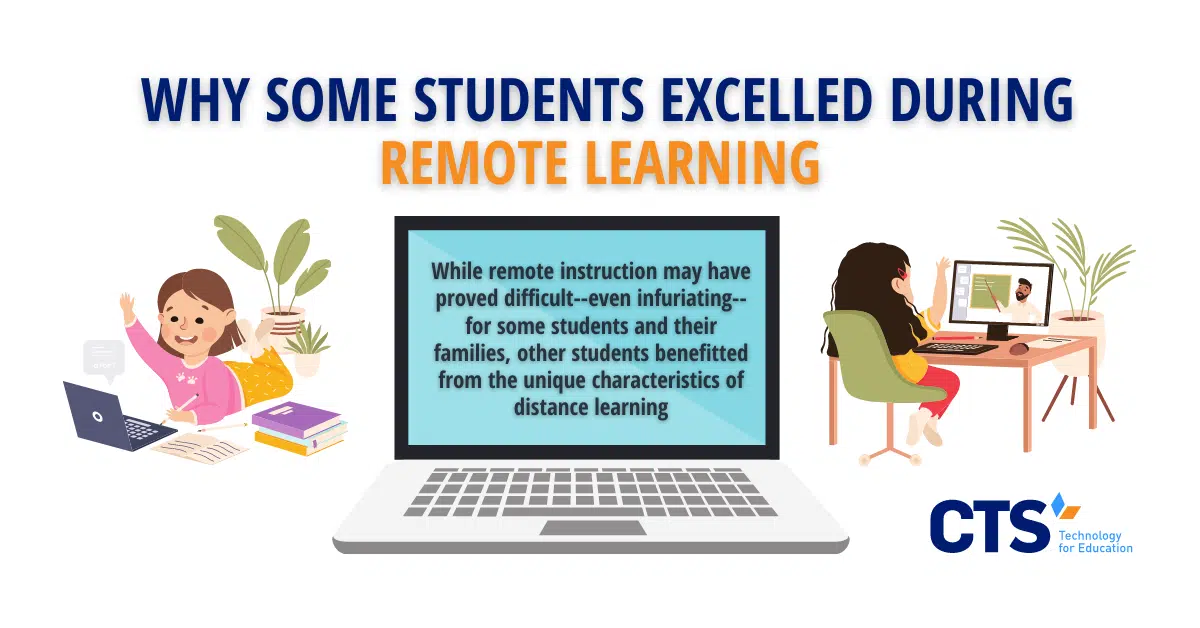As schools reopen this fall, it’s important to take note of why certain students excelled at remote learning.
We’re finally through it–well, at least when it comes to remote learning. As the fall approaches, schools that were once shuttered due to the COVID-19 pandemic are suddenly reemerging, ready to welcome students back to classrooms and, importantly, their peers. Bell schedules will begin to run, as usual, parents will (thankfully for most) be relieved of moonlighting as a teaching assistant, babysitter, etc., during the workday.
For students, this means getting to spend time with their friends, many of whom they haven’t seen in over a year (at least in person), and enjoying the benefits of recess, in-person group projects, and the more general socialization that’s just as important as the instruction they received.
As the shift back to in-person instruction nears, however, it’s important to take note of how and why some students thrived during remote learning. Sure, there were many downsides–in fact, the costs of remote learning almost certainly outweighed the benefits–but for at least some students, remote learning allowed them to access instruction in a way they hadn’t previously. Rather than pushing and pushing all day from one activity to the next, students could take breaks when they began to feel burnout. Instead of rushing to understand a complex problem or concept, students could pace themselves, ensuring they mastered instructional content before moving on to the next task. For others still, remote learning eliminated some of the distractions that inevitably accompany in-person instruction, but that can undermine academic progress. Relieved of the travel time between school and home, students could also get more sleep, which improved focus and alertness throughout the day. Remote learning, finally, forced students to solve difficult math problems and navigate complex texts on their own without the immediate assistance of a teacher.
These and other benefits of remote instruction deserve further study by educators as schools begin to reopen. Indeed, these and other aspects of distance learning promise to reach certain students who don’t respond to traditional instructional methods.
For some students, remote learning prevented burnout.
As anyone who’s worked in a school knows, each minute of the day is typically scheduled, particularly for younger students. The day might begin with an “opening circle” or another morning ritual, followed by a block of phonics, independent reading time, a half-block of science, and then lunch, which is followed by still more discrete units devoted to particular subjects. The constant shuffle from activity to activity, with little time to take a breather, can prove exhausting for many students.
Remote learning shifted this paradigm, allowing students to slow down and, well, just take a break between subjects. Maybe a student had already completed the day’s modules, allowing them some “time off” until the next portion of the day’s instruction began. Perhaps a group of students had already completed their group project, so they didn’t need the extra work time the teacher allocated to the class. These and other examples highlight the flexibility remote learning allowed students who might otherwise experience burnout during the school day. For many, it allowed them to absorb the instruction in which they did engage more easily and ultimately improved their academic outcomes.
For other students, self-pacing allowed them to master complex material.
Similarly, remote learning provided students with greater opportunities to work at their own pace, rather than be beholden to the demands of the day’s schedule or the pace of other students who mastered concepts more quickly. One can imagine, for instance, a student faced with an initially daunting lesson introducing the quadratic formula. Rather than being forced to rush through the formula’s slew of variables and mathematical operations, the student could instead take her time mastering the content, step by step, in a way that in-person instruction wouldn’t have allowed. After all, with each minute of the school day scheduled, teachers don’t often have the luxury of scaffolding their lesson plans in a way that makes sense for all learners, some of whom inevitably fall behind and may even fail to master the concept entirely.
Alternatively, some students might quickly master mathematical or other concepts with which their peers struggle. Without the constraints of in-person instruction, these students could move on to other modules assigned by their teachers or at the very least double-check their understanding while other students completed the day’s lesson. In fact, they may have even been able to access higher-level content than they would have encountered during the regular school day.
Either way, self-pacing ultimately personalized the learning experience for students in ways not typically possible using traditional instructional methods.
Leniency, where appropriate, lowered the stakes for anxious students.
Remote learning was, to put it bluntly, much more chill than in-person instruction. Without the hustle and bustle of in-person learning–student shuffling from one class to the next, flurries of noise and activity–some students were able to focus more fully on daily instruction. More importantly, however, remote learning ultimately deemphasized the importance of grades and standardized testing in many schools across the country.
Given the constraints of remote instruction, many school administrators and state policymakers lessened the centrality of regular assessments and, in some cases, annual statewide testing. Students who were otherwise afraid or anxious about receiving a particular score on their state-mandated assessment were relieved of the stress that often accompanies high-stakes testing. Grades for individual classes, too, were often deemphasized. Students who would have failed a class during remote instruction often experienced greater leniency from teachers than they would have during in-person learning.
This isn’t to say that schools allowed students to get away with not doing their work, far from it. Rather, the deemphasis on testing and grades that accompanied remote instruction allowed students the space to do their best work, relieved from the stress of having their achievement–or, to some, their very intelligence–reduced to an individual score on an assessment or letter grade in a particular class.
Remote learning also eliminated certain distractions that, on balance, proved beneficial for certain students.
Distance learning also eliminated many of the most common distractions that can stand in the way of students’ content mastery. While the pandemic sadly prevented students from seeing their friends on a regular basis (at least in the early days), the constant chatter of the school day often proved distracting for many kids, particularly those with attention deficit or other conditions that made them prone to such distractions. Similarly, relieved from some of the social pressures of in-person instruction–for example, “who has the newest tech. gadget?”–students could instead channel their attention to their learning in a way they may not have previously. A student known as the “class clown” was suddenly relieved of her audience, while another known to be particularly chatty could no longer whisper to his friends during class.
While this aspect of remote learning undoubtedly caused anxiety to some students–indeed, in-person socialization is both crucial to students’ development and a necessary component of schooling–mitigating at least some of the social distractions of in-person instruction undoubtedly helped a subset of students engage content in a manner they wouldn’t have otherwise.
Distance learning allowed students to get more rest than they would on a traditional schedule.
Perhaps most importantly, distance learning allowed students to get more sleep. Without the time needed to travel to school, students could get a precious few more minutes, or even hours, of sleep each night than they would during in-person learning. It doesn’t take a genius to know that more sleep means more alertness, focus, and ultimately productivity, all of which support student learning. While many schools have adopted mindfulness and other “rest” periods during the day, remote learning underscored for many students and families the importance of rest to both mental and physical health. For high school students who once had to wake up at 6:00 AM or even earlier, the addition of just a few more minutes of sleep each night undoubtedly supported their focus during the remote school day. Rather than sleeping in class, students could “travel” to school fully engaged and ready to absorb the day’s instruction.
At CTS, we help schools navigate the challenges of remote and in-person instruction.
When the pandemic first began in the spring of 2020, our team sprang into action to help schools navigate the difficult (and rapid) shift to distance learning. From setting up designated helplines to helping schools get a handle on their student and staff device inventories, our team was solely focused on ensuring our school partners had the tools they needed to successfully manage their remote learning programs.
We’ve worked with more than sixty schools across the country to harness the power of technology to boost student achievement. In addition to our technical know-how, we view ourselves as deeply invested in the mission of each of our partner schools and help craft technology programming that suits the needs of a school’s instructional design. Contact us today to learn more about our services and how we can help your school accomplish its unique mission.




